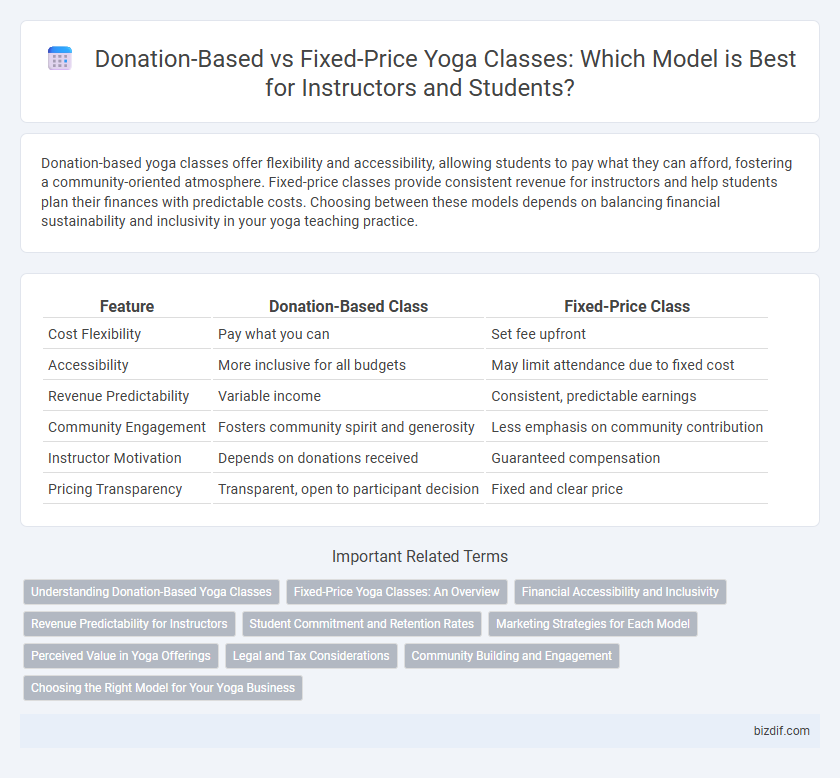Donation-based yoga classes offer flexibility and accessibility, allowing students to pay what they can afford, fostering a community-oriented atmosphere. Fixed-price classes provide consistent revenue for instructors and help students plan their finances with predictable costs. Choosing between these models depends on balancing financial sustainability and inclusivity in your yoga teaching practice.
Table of Comparison
| Feature | Donation-Based Class | Fixed-Price Class |
|---|---|---|
| Cost Flexibility | Pay what you can | Set fee upfront |
| Accessibility | More inclusive for all budgets | May limit attendance due to fixed cost |
| Revenue Predictability | Variable income | Consistent, predictable earnings |
| Community Engagement | Fosters community spirit and generosity | Less emphasis on community contribution |
| Instructor Motivation | Depends on donations received | Guaranteed compensation |
| Pricing Transparency | Transparent, open to participant decision | Fixed and clear price |
Understanding Donation-Based Yoga Classes
Donation-based yoga classes foster inclusivity by allowing participants to pay what they can, removing financial barriers and encouraging community engagement. These classes rely on voluntary contributions, which can vary widely, making budgeting unpredictable for instructors but accessible for diverse practitioners. Embracing donation-based models promotes a flexible, supportive environment where the focus remains on wellness and shared energy rather than fixed fees.
Fixed-Price Yoga Classes: An Overview
Fixed-price yoga classes offer participants a consistent fee, ensuring predictable revenue for instructors and streamlined budgeting for students. These classes often include structured schedules, defined session lengths, and specific instructional content, enhancing clarity and commitment. Many studios use fixed pricing to maintain class quality, instructor compensation, and operational sustainability.
Financial Accessibility and Inclusivity
Donation-based yoga classes promote financial accessibility by allowing participants to pay what they can, removing cost barriers and fostering inclusivity among diverse economic backgrounds. Fixed-price classes ensure consistent revenue for instructors but may exclude individuals with limited financial resources, thereby reducing overall inclusivity. Emphasizing donation-based models supports a welcoming environment that prioritizes equity and broad community participation in yoga practice.
Revenue Predictability for Instructors
Donation-based yoga classes offer instructors flexible income but lack consistent revenue predictability, making monthly financial planning challenging. Fixed-price classes guarantee a set fee per session, providing reliable and steady income streams that support budgeting and growth strategies. Instructors aiming for financial stability often prefer fixed pricing to minimize income fluctuations and uncertainties.
Student Commitment and Retention Rates
Donation-based yoga classes encourage students to attend more frequently by lowering financial barriers and fostering community trust, which enhances long-term commitment and retention rates. Fixed-price classes provide clear pricing, potentially attracting students seeking structured schedules but may limit attendance due to cost concerns. Studies show donation-based models can achieve higher retention by prioritizing accessibility and student-driven value perception.
Marketing Strategies for Each Model
Donation-based yoga classes leverage community engagement and social proof by encouraging participants to contribute according to their means, enhancing accessibility and fostering loyalty through personalized follow-ups and social media storytelling. Fixed-price classes benefit from clear value propositions and targeted promotions such as early-bird discounts, package deals, and referral programs to boost commitment and predict revenue. Both models use data analytics to optimize class schedules and tailor marketing campaigns, but donation-based classes emphasize emotional connection while fixed-price classes prioritize consistency and perceived value.
Perceived Value in Yoga Offerings
Donation-based yoga classes create a sense of community and accessibility, empowering participants to value their practice based on personal commitment rather than cost. Fixed-price classes often enhance perceived value by signaling professional quality and providing consistent, structured instruction. Both models affect how practitioners assess the worth of their yoga experience, influencing enrollment and long-term engagement.
Legal and Tax Considerations
Donation-based yoga classes may require clear documentation to comply with nonprofit regulations and avoid misclassification as taxable services, while fixed-price classes are straightforwardly treated as taxable business income under IRS guidelines. Tax-exempt status often depends on the yoga instructor or studio's organizational structure, with donation classes needing compliance with local laws governing charitable contributions. Accurate record-keeping and transparent communication with tax authorities minimize risks of audits or penalties for both donation-based and fixed-price yoga instruction models.
Community Building and Engagement
Donation-based yoga classes foster a strong sense of community by encouraging generosity and inclusivity, allowing participants to contribute according to their means and feel more connected. Fixed-price classes offer financial stability for instructors but may limit accessibility and reduce diverse engagement within the community. Emphasizing donation-based models can enhance participant interaction and create a supportive, flexible environment that nurtures long-term engagement.
Choosing the Right Model for Your Yoga Business
Donation-based yoga classes foster community engagement and inclusivity, allowing students to pay what they can and encouraging regular attendance. Fixed-price classes provide predictable revenue streams and simplify financial planning, making it easier to manage expenses and scale the business. Assess client demographics, cash flow needs, and long-term goals to determine the optimal pricing model that balances accessibility with sustainability for your yoga business.
Donation-Based Class vs Fixed-Price Class Infographic

 bizdif.com
bizdif.com